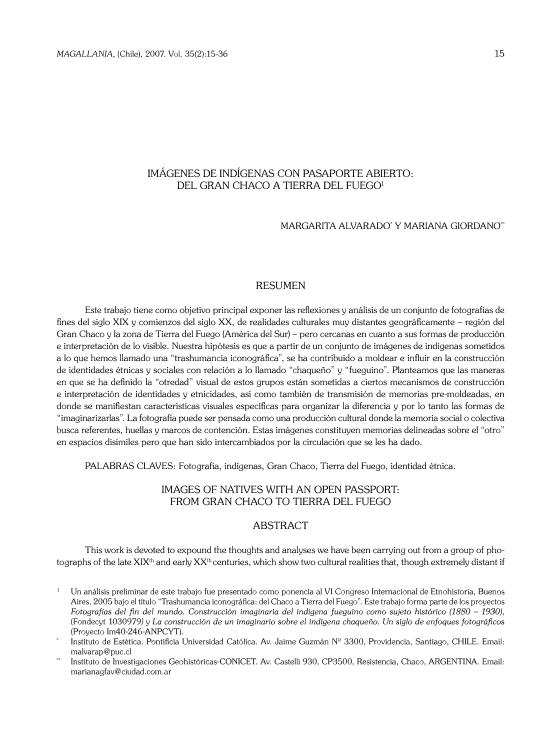Artículo
Este trabajo tiene como objetivo principal exponer las reflexiones y análisis de un conjunto de fotografías de fines del siglo XIX y comienzos del siglo XX, de realidades culturales muy distantes geográficamente – región del Gran Chaco y la zona de Tierra del Fuego (América del Sur) – pero cercanas en cuanto a sus formas de producción e interpretación de lo visible. Nuestra hipótesis es que a partir de un conjunto de imágenes de indígenas sometidos a lo que hemos llamado una “trashumancia iconográfica”, se ha contribuido a moldear e influir en la construcción de identidades étnicas y sociales con relación a lo llamado “chaqueño” y “fueguino”. Planteamos que las maneras en que se ha definido la “otredad” visual de estos grupos están sometidas a ciertos mecanismos de construcción e interpretación de identidades y etnicidades, así como también de transmisión de memorias pre-moldeadas, en donde se manifiestan características visuales específicas para organizar la diferencia y por lo tanto las formas de “imaginarizarlas”. La fotografía puede ser pensada como una producción cultural donde la memoria social o colectiva busca referentes, huellas y marcos de contención. Estas imágenes constituyen memorias delineadas sobre el “otro” en espacios disímiles pero que han sido intercambiados por la circulación que se les ha dado. This work is devoted to expound the thoughts and analyses we have been carrying out from a group of photographs of the late XIXth and early XXth centuries, which show two cultural realities that, though extremely distant if seen from a geographical point of view, are really close if focused from their ways of producing and interpreting the visible world. Our hypothesis is that, thanks to a group of images of natives that were subjected to what we have called ‘an iconographic transhumance’, there has been a contribution to the modelling and construction of the ethnic and social identities regarding the so-called ‘Chaqueño’ and ‘Fueguino’ natives. We state that the ways in which the visual ‘otherness’ of these groups have been defined are subjected to certain mechanisms of construction and interpretation of identities and ethnicities, as well as to others of transmission of pre-moulded memories, in which certain specific visual features become manifest in order to organize the difference and, thus, the ways of ‘imaginaryzing’ them. Photography can be thought of as a cultural production where the social or collective memory looks for referents, traces, and retaining frameworks. These images are memories that were outlined over the ‘other’ within dissimilar spaces, which have nonetheless been interchanged through the circulation they have been subdued to.
Imágenes de indígenas con pasaporte abierto: del Gran Chaco a la Tierra del Fuego
Título:
Images of natives with an open passport: from Gran Chaco to Tierra del Fuego
Fecha de publicación:
11/2007
Editorial:
Universidad de Magallanes. Instituto de la Patagonia
Revista:
Magallania
ISSN:
0718-2244
e-ISSN:
0718-0209
Idioma:
Español
Tipo de recurso:
Artículo publicado
Clasificación temática:
Resumen
Palabras clave:
Fotografía
,
Gran Chaco
,
Tierra del Fuego
,
Indígenas
,
Identidad Étnica
Archivos asociados
Licencia
Identificadores
Colecciones
Articulos(IIGHI)
Articulos de INST.DE INVEST.GEOHISTORICAS (I)
Articulos de INST.DE INVEST.GEOHISTORICAS (I)
Citación
Alvarado, Margarita; Giordano, Mariana Lilian; Imágenes de indígenas con pasaporte abierto: del Gran Chaco a la Tierra del Fuego; Universidad de Magallanes. Instituto de la Patagonia; Magallania; 35; 2; 11-2007; 15-36
Compartir
Altmétricas




